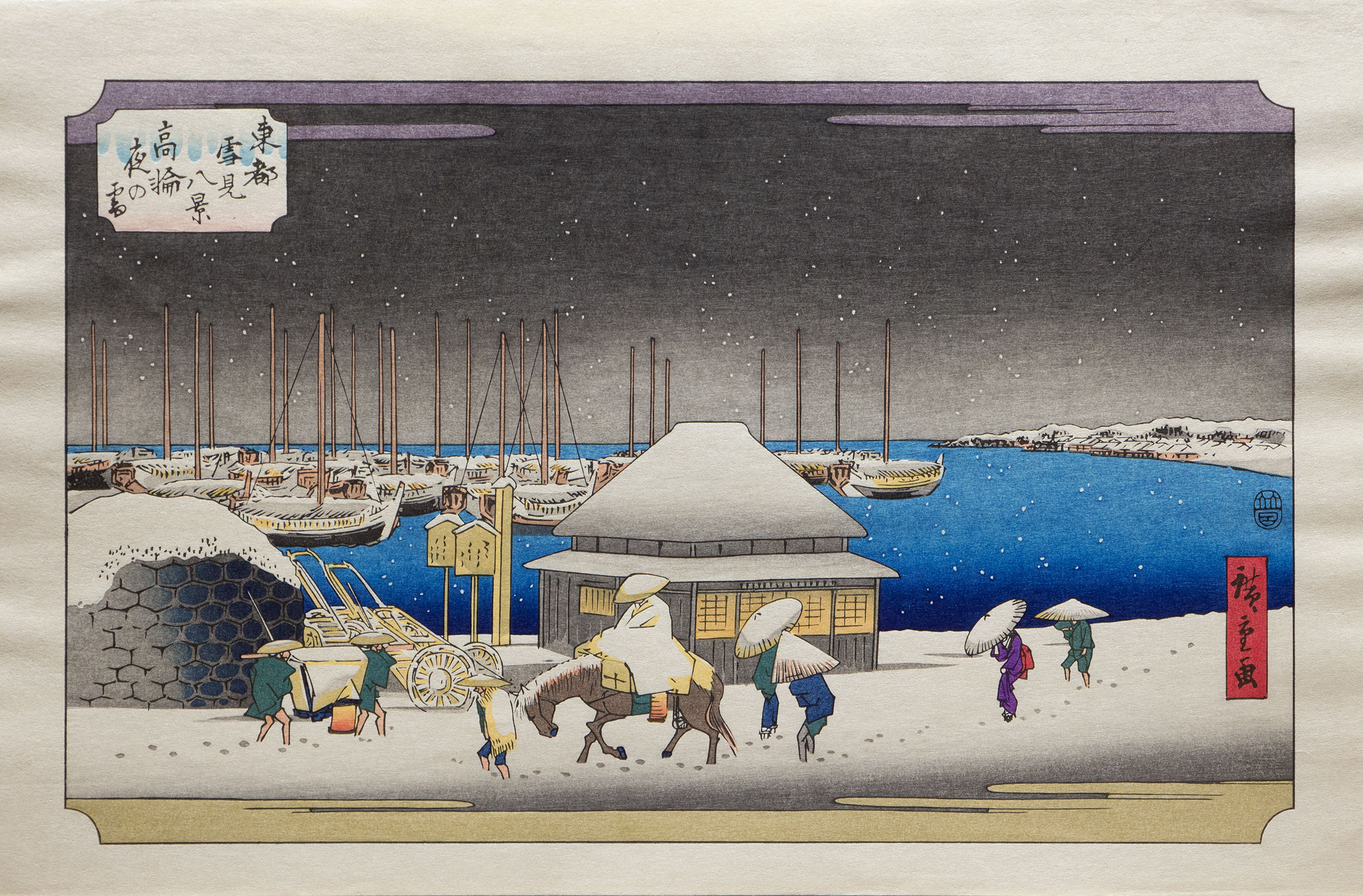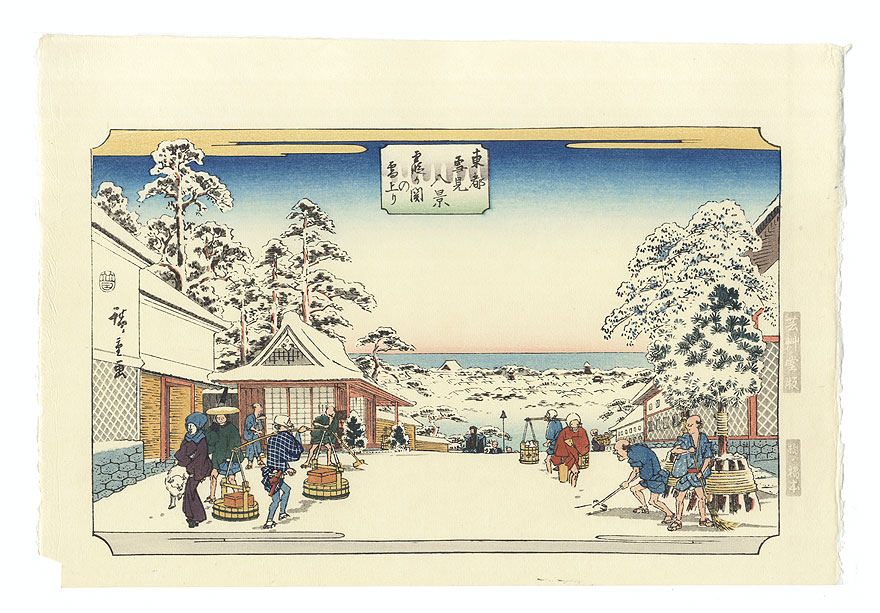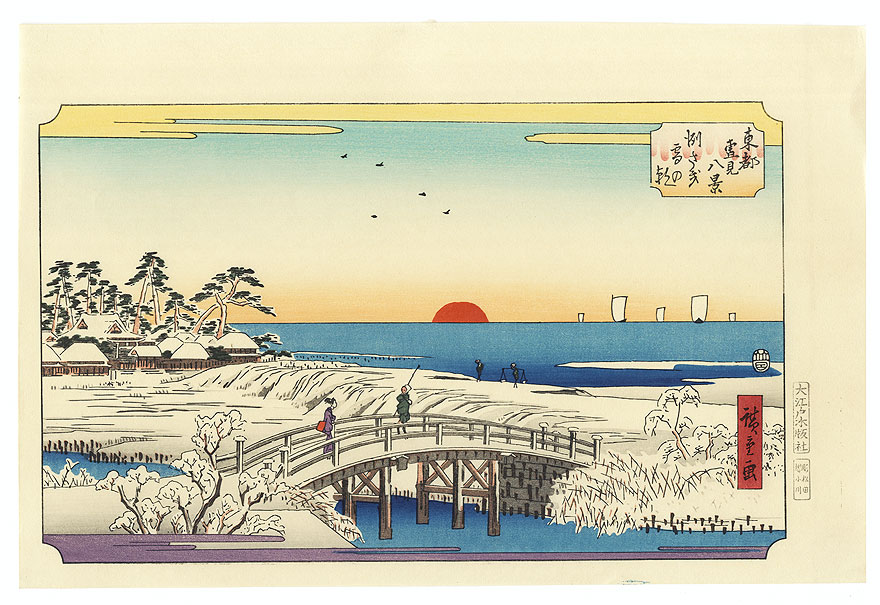Utagawa Hiroshige (1797-1858) was one of the most prolific and popular Ukiyo-e artists in Japan. The word Ukiyo-e means pictures of the floating world. They were woodblock prints developed during the Tokugawa shogunate in the Edo [Tokyo] period. A time of increased wealth, the Edo period embraced kabuki theatre, geishas, and courtesans. The early Ukiyo-e prints were produced from the late 17th to the early 18th Century. They began as black and white woodcuts. White was the color of the paper. Color was added later. The color palette was limited as each color was cut from a different block. A certain amount of shading could be added to a block as artistically needed.
Utagawa Hiroshige was the last great master of the style. Born in Edo into a samurai family, he was orphaned in 1809. His father held the position of fire warden in charge of preventing fires in the Edo palace, a responsibility passed down to Utagawa. The fire warden had much free time, so Utagawa entered the Utagawa Art School, from which he took his first name. He was permitted to sign his work at age 12, and he took his art name Hiroshige.

Evening Snow at Takanawa (1842-47)
“Evening Snow at Takanawa” (1842-47) (8.5’’X13.5’’) (scene 2) is one of eight scenes Hiroshige made for the portfolio Eight Snow Scenes in the Eastern Capital. Unlike other ukiyo-e artists whose subjects were mostly images of geishas, courtesans, and kabuki actors, Hiroshige focused on landscapes. His early prints were of flowers and birds. Most of his works were his series of travel prints that he began in 1829-1830. He was invited in 1832 to join an official procession on the Tokaido Road from Edo (Tokyo) to Kyoto. “Fifty-Three Stations of the Tokaido Road” (1833-34), completed from his sketches and notes when he returned home, made him one of the most recognizable and popular ukiyo-e artists of his time.
“Evening Snow at Takanawa” (1842-47) (8.5’’X13.5’’) (scene 2) is a panoramic view of a vibrant snow-white bank by deep blue water and under a grey sky. White snowflakes dot the sky and the water. Aware of European perspective, Hiroshige depicts the snow bank with a slightly gray front edge and a darker blue at the front edge of the water. The closer the object the more intense is its color, which then diminishes as distance is created. In reverse, the sky is a lighter gray at the water’s edge and becomes darker as it recedes into the distance. Holding it all together are the clouds and land at the front and back edges of the print, repeating the beige and gray pattern.
Fishing boats are anchored in the harbor. The colors of the boats repeat the black, white, and yellow-orange used to define the other objects in the print. The stone building is composed of gray, and a darker gray blue, with the white snow covering the roof. The house is gray with yellow-orange windows, and covered by a gray roof covered with the white snow. Several yellow carts are placed next to the stone building. The palanquin, a one passenger litter, is carried by two bearers dressed in green. Trudging through the snow is a man in bright blue pants, leading a horse and rider. Behind them, a man carrying an umbrella wears green pants and a dark blue jacket. Also carrying an umbrella, is a woman who wears a purple kimono and geta shoes that are built up with wood to keep her feet out of the snow. An obi, the red tied decoration on her back, is not a backpack but an elaborately tied part of the kimono. The artist’s signature, a go or geimei, also is in red.

“Snow in the Grounds of the Fudo Shrine at Megura”
“Snow in the Grounds of the Fudo Shrine at Megura” is the third print in the series. It is a depiction of a Buddhist Temple dedicated to the deity Fudo Myo-o, the immoveable or unshakable one, a fierce looking and powerful deity who protects Buddhism and its believers. The shrine, located on a tall hill covered with pine trees, still exists. The red shrine is placed at the center of the composition, and it is balanced with a narrow blue lake and brown building, a long set of stone steps on the hill, and the red signature of the artist. The dark green of the surrounding trees is the complementary color to the red shrine with its green shutters. The day is bright, and the few people present do not engage with each other. The shrine, as depicted by Hiroshige, is a beautiful and restful place just outside the hustle and bustle of the city below.

“Street View, Looking Down the Kasumigaseki after a Snowfall”
“Street View, Looking Down the Kasumigaseki after a Snowfall” is number 5 in the series. Kasumigaseki was, and is today, a busy hill street in Edo (Tokyo). Hiroshige depicts the panorama of Edo roof tops and a tower at the bottom of the hill. He concentrates on the people at the top of the hill who are going about their daily tasks. It is the morning after a snowfall, and workers on either side of the road are clearing the snow. Two men with shoulder poles carry boxes and cages. Buildings line the street. Kasumigaseki Street will become the street of important government buildings.

“Street View, Looking Down the Kasumigaseki after a Snowfall” (detail)
In the “Street View, Looking Down the Kasumigaseki after a Snowfall,’’ viewers have the opportunity to witness the brilliance of Hiroshige’s wood cut details produced in such a small area.

Snow at New Years Dawn at Susaki”
Japanese New Year is a celebration which begins on January 1 and continues until January 3. “Snow at New Years Dawn at Susaki,” plate 8 of the series, depicts the first sunrise that will represent the entire year. On this January day, the sky is clear, and new snow has fallen. A few people have come out to witness the rising of the Sun. A woman in a purple kimono and a man with a fishing pole greet the day. Two others stand at the water’s edge of Susaki Bay, one man with his shoulder pole and the other balancing something on his head. Five sails move across the blue water. The nearby village is peaceful. All last year’s business has been settled so that the New Year will begin afresh. New Year’s Day is supposed to be free of stress and anger left in the past. The day is to be full of joy and new beginnings.
Hiroshige created over 8000 Ukiyo-e wood cuts during his career. Many were in series formats. His final series was One Hundred Famous Views of Edo (1856-1859). He was never a wealthy man, as he was paid little for his work. He had two wives and one daughter, who may have been adopted. In 1856 he became a Buddhist Monk and retired from the world to complete One Hundred Famous Views of Edo. Ten years later the trade between Europe and Japan brought hundreds of Japanese woodcuts to Paris. Artists such as Monet, Van Gogh, and Whistler became collectors of Hiroshige’s prints, and his works influenced their own. Japonisme started a craze that exists today. Hiroshige died in 1858 and left this final message for his friends:
“I leave my brush in the East,
And set forth on my journey.
I shall see the famous places of the Western Land.”
Beverly Hall Smith was a professor of art history for 40 years. Since retiring to Chestertown with her husband Kurt in 2014, she has taught art history classes at WC-ALL and the Institute of Adult Learning, Centreville. An artist, she sometimes exhibits work at River Arts. She also paints sets for the Garfield Theater in Chestertown.



Write a Letter to the Editor on this Article
We encourage readers to offer their point of view on this article by submitting the following form. Editing is sometimes necessary and is done at the discretion of the editorial staff.